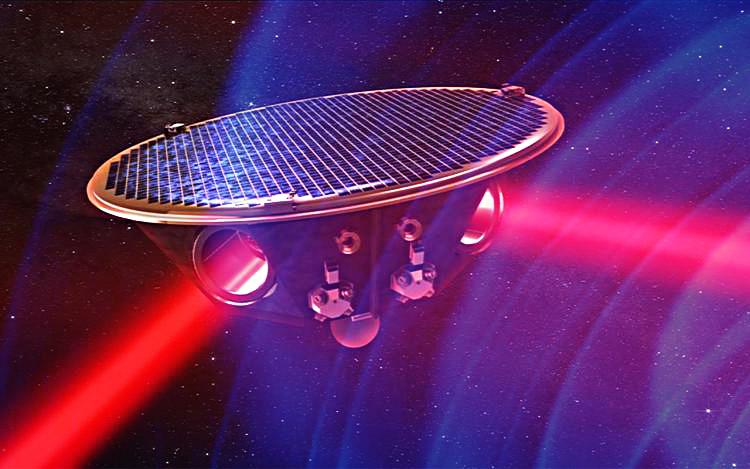Farewell, LISA Pathfinder! Test Mission for Gravitational-Wave Tech Ends
After 16 months of testing technologies that can detect the ripples in space-time known as gravitational waves, the LISA Pathfinder spacecraft shut down on Tuesday (July 18), the Max Planck Institute for Gravitational Physics in Germany announced.
LISA Pathfinder — a proof-of-concept mission launched by the European Space Agency — was turned off as planned as its mission came to an end. The spacecraft will continue to circle the sun in a parking orbit as the agency turns its attention to newer missions.
The mission didn't study gravitational waves directly, but instead tested out new technologies for a 2034 follow-up mission, the Laser Interferometer Space Antenna (LISA), which will detect and accurately measure those space-time ripples. [Gallery: The Search for Gravitational Waves]
"When we were in contact with LISA Pathfinder [Tuesday] evening for the last time and said goodbye to the satellite, it was a unique and emotional moment," Karsten Danzmann, Max Planck Institute director and Lisa Pathfinder co-investigator, said in a statement.

"This mission has been outstanding," said Paul McNamara, LISA Pathfinder project scientist, in a new YouTube video released by ESA. "From the operations to the hardware to the development, it's just been a wonderful mission."
They key testing technology on LISA Pathfinder consisted of two gold-platinum cubes, each weighing 4.3 lbs. (2 kilograms) and measuring about 1.8 inches (4.6 centimeters) in diameter. The cubes were suspended inside the spacecraft, and a laser measured the distance between them — nominally 1.5 inches (3.8 centimeters) — for changes in their orientation, distance and position.
"We can determine the distance of the two free-falling test masses to less than the diameter of a single atom," Gerhard Heinzel, leader of the Interferometry in Space research group at Max Planck, said in a 2016 statement.
Get the Space.com Newsletter
Breaking space news, the latest updates on rocket launches, skywatching events and more!
In 2016, LISA Pathfinder's cubes achieved a near perfect free fall in space, which demonstrated that scientists could precisely control the cubes' positions for future gravitational wave hunts.
LISA, slated to launch in 2034, will consist of three satellites positioned in a triangle, with each satellite about 1.55 million miles (2.5 million kilometers) from each other — about six times the distance to the moon.

Each spacecraft will have a similar technology to LISA Pathfinder's cubes, called a "free-falling mass," nested inside. Gravitational waves will distort the spacecraft's distances to each other by only a trillionth of a meter, requiring precise measurements.
Gravitational waves, ripples in space-time first theorized by Albert Einstein a century ago, are produced by large events in space such as supernova explosions, or the mergers of black holes. Black-hole mergers have been detected several times by the Laser Interferometer Gravitational-Wave Observatory (LIGO) consortium, which operates detectors in Washington state and Louisiana.
However, LIGO and other ground-based detectors and can see only some kinds of gravitational waves. It takes a space-based observatory to avoid interference from seismic activity and other distortions on Earth. LISA will detect lower-frequency waves than those found by LIGO, focusing on events such as supermassive black hole collisions.
"We're looking for the universe vibrating from these mergers, these big, big events," McNamara added in the video. "It's something you can never, ever do on the ground. So LIGO would never be able to see the events that we see with LISA."
Follow us @Spacedotcom, Facebook or Google+. Originally published on Space.com.
Join our Space Forums to keep talking space on the latest missions, night sky and more! And if you have a news tip, correction or comment, let us know at: community@space.com.

Elizabeth Howell (she/her), Ph.D., was a staff writer in the spaceflight channel between 2022 and 2024 specializing in Canadian space news. She was contributing writer for Space.com for 10 years from 2012 to 2024. Elizabeth's reporting includes multiple exclusives with the White House, leading world coverage about a lost-and-found space tomato on the International Space Station, witnessing five human spaceflight launches on two continents, flying parabolic, working inside a spacesuit, and participating in a simulated Mars mission. Her latest book, "Why Am I Taller?" (ECW Press, 2022) is co-written with astronaut Dave Williams.









